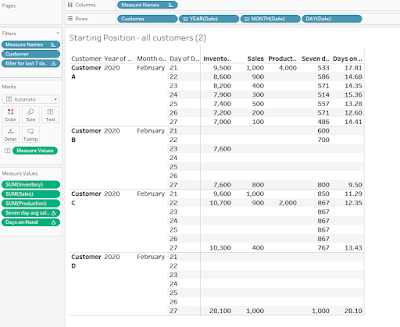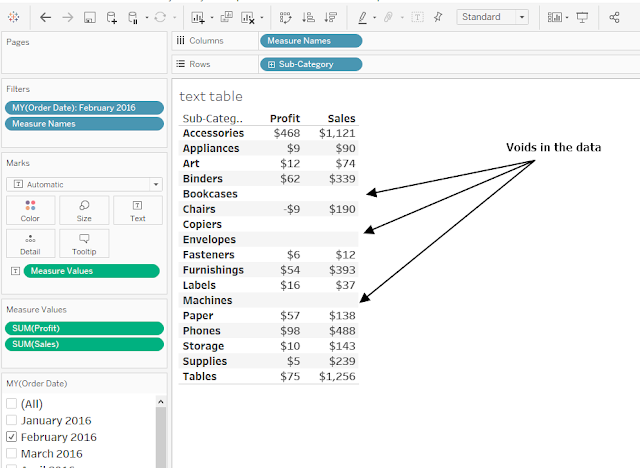My blog has moved to jimdehner.com
Thank you for all the support over the past 2 years - I recently updated my blog to make it easier to read, improve the rendering of images and tie back to video presentations that are associated with the content - Check it out at Jim's new blog -
Data structure has a huge affect on the results you get from your analysis. Like most of you, I trained using well structured and full data sets - where there was a value in every record (cell) - like a tightly fit puzzle - (Note - Presented that the Atlanta TUG in Sept 2021 - see the recording at Video link )
With real world data that is often not the case. Data can come from ERP systems, stand alone third party or public sources and contains voids or is sparse or otherwise badly structured resulting in gaps in the data.
Scaffolding is one way to re-structure the data and fill the gaps.
We are going to look at 3 different frequently encountered use case where data needs to be scaffolded to solve the problem. The cases are adapted from actual questions that were posted on the Forum - data and names changed
The '2 Date Problem' is a classic case - each record in the data has a start date and end date and you need to look at all the periods in between. It comes up when you need to count the active programs, total cash flow over a series of mortgages or annuities, or, as in this example count head count over time.
The question came from an HR manager who had a number of open positions. Each had an "open date", some had been filled and others were still open. The manager wanted to count all the open positions and separately those filled by month.
The data looked like this:
Each requisition had start and end dates as independent values but there was no calendar common to every record. The solution was to build a calendar using a scaffold. In this case, the manager was only interested in monthly totals so a monthly date ladder would suffice:
The scaffold and the base data were joined so that every record in the base data was connected to each record in the scaffold - a "Cartesian join" - with a 1=1 join clause
Using the scaffold date resulted in a calendar that included each job requisition
All that was need were 2 LOD expressions to count the filled or open jobs by month
the filled LOD is
{ FIXED [Job Ref ID1] , [Scaffold Date]: countd( if not ISNULL([Job open date])
and DATETRUNC('month',[Job filled date])=DATETRUNC('month',[Scaffold Date])
then [Job Ref ID1] end )}
and the open LOD is
{ FIXED [Job Ref ID1] , [Scaffold Date]: countd(
if DATETRUNC('month',[Job open date])<= DATETRUNC('month',[Scaffold Date])
and ( DATETRUNC('month',[Job filled date])>DATETRUNC('month',[Scaffold Date])
or ISNULL([Job filled date]))then [Job Ref ID1] end )}
and the result looked like this
By using the date scaffold to create a calendar, the solution was reduced to just checking each month to see which positions were still open and which had been filled.
2 When drilling down breaks the analysis
Data that appear to be solid a high levels of aggregation can be sparse or have voids when drilling down a dimension hierarchy or to lower date levels. The problem is common with data that comes from ERP systems (like Oracle or SAP). ERP systems are transaction driven and only create a record when a transaction takes place e.g. if there are no sales for a particular SKU on a date there is no record in the data set.
To illustrate the issue we will look at an inventory analysis where a production planner wanted to calculate a very common metric used as an indicator that inventory levels were either too high or low.
For those not familiar with EPR systems and the forecasting to production process, a quick review. The ERP system records sales directly from the sales invoice. That data is precise - we know the customer, the date, the SKU (stock keeping unit), the unit quantity and the dollar value. The data can then be aggregate along several different hierarchies - here along the product and is still very accurate although somewhat less useful
Forecasters and product managers will use the sales history to create a rolling forecast that is used by the production planning and purchasing departments to develop the production schedule. The process starts at the top on the pyramid and works downs, each level being a lower level of aggregation that is more useful to the planner but less accurate than the preceding Forecast are usually adjusted monthly along a 3 or 4 month forecasting horizon. The production schedulers take the lowest level -Units by SKU by week and schedule production, purchase components, and plan inventory levels. While the forecasting and planning process are numbers in the system and the results become less accurate at lower levels in the pyramid, actual production and inventory levels are precise. You know exactly how many units were produced for each SKU and the inventory levels.
With the uncertainties in the process, planners track a metric as an early warning when the forecast is too high or the inventory too low so they can adjust the production schedule. The metric is Days on Hand (or days Sales, or just Days). The calculation is just
Sum(Inventory level) / Average daily sales
That is where the user question fits in. He was an production planner manager and was planning a single item, had 4 customers to consider and was pulling sales, inventory and production data from their ERP system. The data looked something like this with a separate file for each customer:
He was getting different Days on Hand results that could not be reconciled for individual customers or across the group as a whole.
After filtering the results to show only the last date and they looked something like this across all 4 companies:
But some results look odd
So lets see what is going on:
First the formula for the Seven Day Avg Sales is window_avg(sum([Sales]),-6,0)
and that is a clue to the first problem - Window average is a table calculation that looks at the last 7 records, not days but this is what the actual data looked like when all the records were visible
Many Nulls - very sparse data and it is clear that for Customer D there was only 1 sale in the final 7 days and that was for 1000 units so the average did not take into account the nulls. The nulls in the data were "no record null" see Null Types and a scaffold is needed to be used to force a record into the data for each combination of customer name and date.
Tableau Prep was used to force the record into the data - the first step joins the customer list to the date list (Cartesian)
The second joins the original data to the ladder
after scaffolding the last seven data data looks like this ( note zn() functions and previous applied ) - and the data now runs through the end of February
and the last day summary across the 4 companies is
The actual Days on Hand when the missing data has been include is very different than the original results. This is a case where the planner (the Subject Matter Expert) would not know what the data structure looks like nor should he - that is the role of the dashboard designer and data scientist - It is also a by product of the data source - the ERP system that could affect your next analysis
3 Voids in the data
Voids, single or small groups of no records nulls in the data, will return a null (blank screen) if the unsuspecting user filters to that combination of dimensions.
The user had created a viz using small multiples - a great way to see the changes across all values of a dimension in a single view - here using Superstore data (note there are 17 images one for each sub-category in the data set)
When the date is filtered to on February 2016, 4 images disappeared (returned a null)
The user had 2 questions - Why did it happen and then how to correct the problem
When the user filtered to February there are no records in 4 subcategories - the voids returned Nulls causes the 4 image to "disappear"
Here using a scaffold to force a record into each void will solve the problem.
I used Tableau Prep to create the scaffold. First Cartesian join the date and subcategory fields
Then connect that to the Superstore dataset
But scaffolding exploded the data set to 28,000 records - at the same time it did solve the users problem
Sometimes it is necessary to think beyond calculations and functions to create the viz you want to present and then it is often that the data need to be re-structured. When the data contains voids or is missing records, scaffolding is an option to make the data set solid.
Hope this helps you better understand when and how to use different forms of scaffolding. The workbook used here can be downloaded at Link to Examples
Enjoy
Jim
also see the video presentation on VizConnect at Video at


























